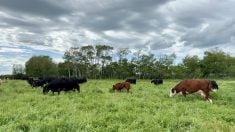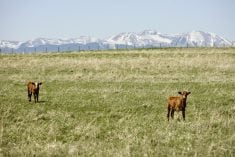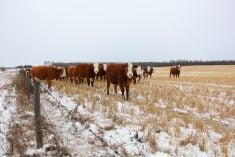Cows and bred heifers require 25 per cent more nutrients after calving than during late pregnancy. Milk production peaks eight weeks after calving. Feed intake increases until 12 weeks after calving. The increased feed intake is the result of the digestive system expanding to fill the space that was occupied by the fetus and reproductive organs pre-calving. These changes coincide with the start of breeding season. Thus, nutrient requirements are highest when the cow is raising a calf and is expected to be receptive to a bull.
There are many different feeds available for cattle rations and factors to consider when selecting feeds for lactation rations.
Hay and silage quality is affected by crop or forage type, maturity at harvest, insect damage, plant diseases and environmental factors. Soil fertility and available moisture are also important. One factor that greatly influences quality is plant maturity, especially when the crop is cut past the flowering stage. Sulieman (1999) studied 13 grass species that were cut at the five-leaf stage onward every week. He reported that protein content declined by two per cent per week and acid detergent fibre (ADF) levels increased by three per cent per week. Higher fibre content reduces energy density, forage digestibility and voluntary feed intake. In hot, dry years, plants develop quicker and are fully mature two to three weeks earlier than normal.
Read Also

Canadian Beef Check-Off Agency reports on investments and activities
The check-off agency’s work behind the scenes is what ensures cattle check-off dollars are invested wisely, accounted for transparently and deliver measurable value back to producers and importers.
Grains are a good source of energy, or total digestible nutrients (TDN), and are usually required in lactating rations. Cereal grains range from 73 to 88 per cent TDN, with oats having the lowest energy density, with corn, rye, triticale and wheat having the highest. Pulse grains have an energy content in the 88 per cent range. Protein content can vary from a low of nine per cent in corn to 24 per cent in peas, lentils and fababeans, and 40 per cent in raw soybeans.
Straw, forage seed aftermath, and corn residue generally do not have enough energy or protein to be included in a lactation ration. On a dry matter basis, these feeds contain approximately 4.5 per cent protein and 45 per cent TDN. Neutral detergent fibre content often is above 60 per cent. These lower-quality feeds take longer to digest which limits the intake of other higher-quality ingredients.
Adjusting a late pregnancy ration to a lactation ration should be done gradually to prevent digestive upsets and animals going off feed.
Simple changes such as switching from dry hay to silage when using the same feedstuff can be done without issues. To replace one pound of dry hay that contains 16 per cent moisture, it takes 2.4 pounds of silage at 65 per cent moisture.
Corn grain and wheat grain have the same energy density, but protein content in wheat can be as high as 15 per cent. Corn has an average of 10 per cent. Protein in barley and oats is between wheat and corn. Adjustment to protein supplementation is required when switching between grains.
Higher energy requirements after calving often require grain or high-energy concentrates in the ration. Increasing feeding rates by one pound every second day is recommended. This allows the rumen microflora to adjust and digest the feed efficiently. If feeding rates are increased too rapidly, manure texture becomes loose and watery. This indicates that the rumen is not healthy and could be acidotic. Reduce feeding rates until the manure returns to a normal texture.
Grain digestion rates are different. Faster digestion rates produce more acid in a shorter period, reducing rumen pH. This can result in subclinical acidosis, bloat and erratic feed consumption. Processed wheat has the quickest digestion rate followed by barley. Corn and oats have slower digestion rates. The extent of processing also affects digestion rate. The finer the grain, the more rapid the digestion and the greater the potential for digestive upsets.
A more complex issue is milk fever. It’s more common in dairy animals but it does occur in beef cattle. Feeding a high legume forage either as hay or silage pre-calving reduces the animal’s ability to stabilize serum calcium levels. To reduce high calcium in the blood, animals mobilize less calcium from the bone. This decreases the ability of the bone to release calcium after calving when requirements are much higher.
Legumes can be fed pre-calving but the dietary cation-anion balance (DCAB) in the entire ration is important. DCAB of the ration is calculated by adding the milliequivalents of sodium and potassium together (cations) minus the sum of chloride and sulphur (anions). A high DCAB ratio reduces mobilization of calcium from the bone. A low or negative DCAB increases calcium mobilization which helps prevent the problem. See Dr. John McKinnon’s Nutrition article in the September 5, 2020 issue of Canadian Cattlemen for more details.
Without feed test results, it is impossible to balance a ration. This is most critical when the cows have the highest nutrient requirements — after calving. Nutrient deficiencies and excesses have an impact on the availability of other nutrients in the ration. Often, we must change mineral formulations to meet requirements. It is equally important to test for trace minerals. For example, high molybdenum and sulphur tie up copper. As well, excess manganese can reduce reproductive efficiency.
Vitamins cannot be ignored. They are essential for metabolism and animal health. Vitamins A and E precursors found in forages become less active over time. Supplementation should start shortly after dry hay, greenfeed or silage is fed.
Minor changes to a mineral and vitamin feeding program can make a big difference to animal health and productivity.
– Barry Yaremcio holds a master’s degree in animal science (nutrition) and a bachelor’s degree in agriculture (animal science). He worked in extension for Alberta Agriculture for several years and now is a ruminant nutritionist and production management consultant. Reach him through beefconsultant.com.
















